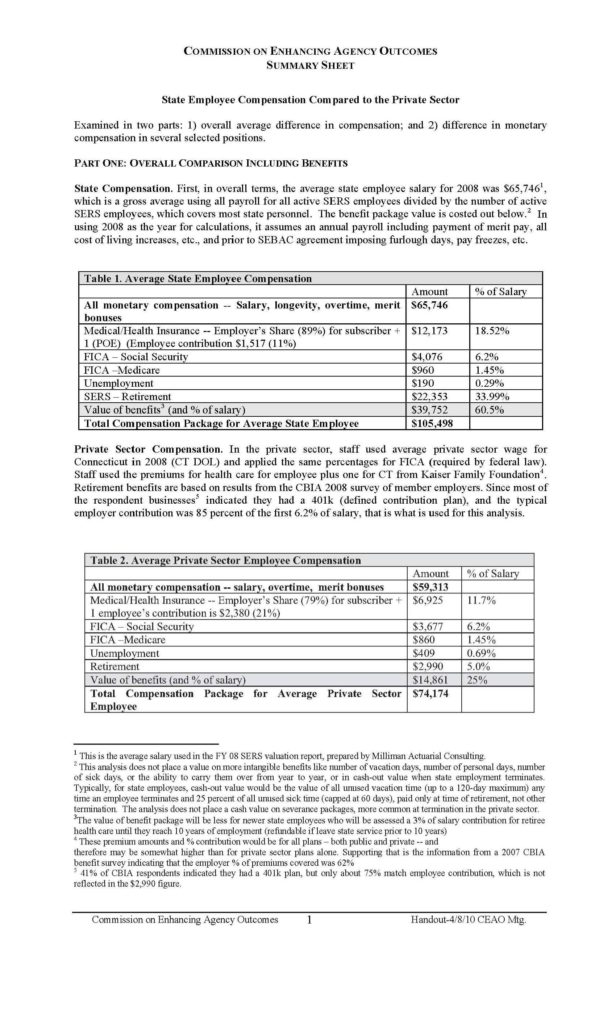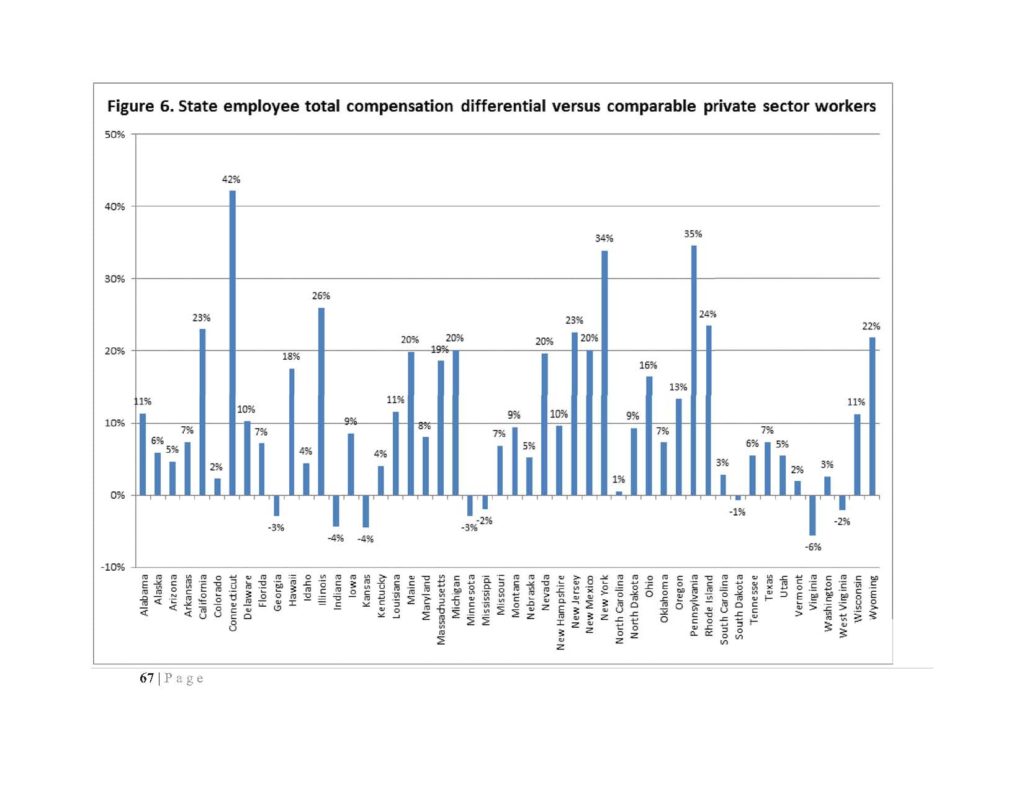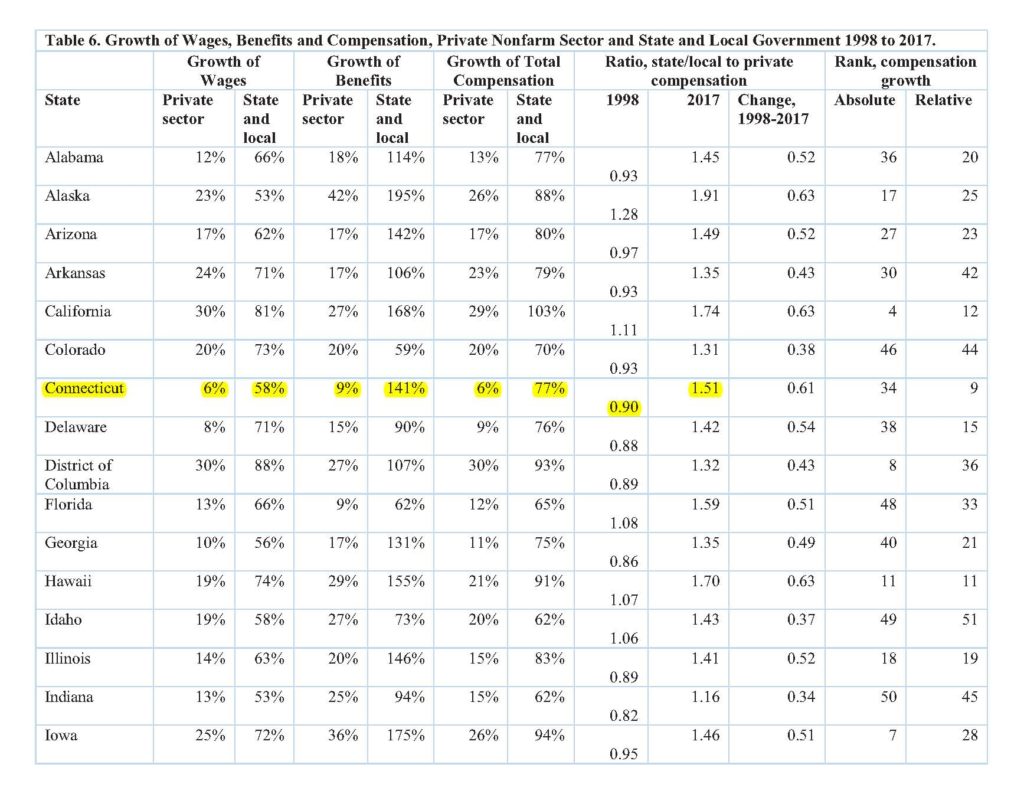
Connecticut Governor Ned Lamont, a Democrat, sees the unfairness of about 50,000 state employees getting a $350 million pay raise next week (on July 1st) [correction: $175 million] while almost 600,000 private sector workers in Connecticut have lost their jobs. He said as much at a mid-June food bank give-away.

It’s not just pay: the state workforce enjoys a contractual no-layoff guarantee through 2021 as well as gold plated health care and pension benefits.
Yet Lamont can’t bring himself to cancel, suspend or even delay the raise, which follows a raise of roughly similar amount a year ago.

As a result of the pandemic, Lamont has the emergency power to override any and all state laws — even provisions of the U.S. constitution such as freedom of assembly, including the right to gather in houses of worship. Yet he says he lacks the power to do more than ask the unions to forgo the raise? Talk about fecklessness.

The Yankee Institute reports that Democrat governors in New York, Pennsylvania and Virginia have temporarily suspended raises or frozen pay for state employees. Without emergency power, President Obama reminded everyone that “I have a pen and a phone.” One wonders what Lamont has – or hasn’t.


This issue of fair pay is not new. The gap between the compensation of Connecticut state employees and the state’s private sector workers is enormous and has been for at least a decade and a half, despite the whining of state employees, union bosses and union negotiators about all the “sacrifices” they’ve supposedly made.
In 2010, the state conducted its own study of total compensation, finding average state employee compensation of $105,000 versus an average of $74,000 in the state’s private sector. That’s a whopping 42 percent compensation premium in favor of state employees.
In 2014, a study by the American Enterprise Institute (AEI) found the same 42 percent compensation premium – the biggest of all 50 states. It wasn’t just benefits. Connecticut was the only state where average state employee wages were higher than average private sector wages. Note, this was a 50 state study, so the AEI researchers couldn’t “cook the books” to make Connecticut, or any state, look good or bad.
In 2019, AEI conducted another 50 state study, this time comparing all public sector employees (state and municipal) to private sector workers. Based upon the latest data (2017), Connecticut’s pay gap had widened to 51 percent. Notably, the 2017 data predates the 5.5 percent raise last year and the 5.5 percent wage increase next week, which will propel state workers even further ahead of the state’s beleaguered private sector workers.

This compensation disparity is unfair no matter how or when you look at it. And Lamont won’t act, and the unions won’t concede?
Instead of offering concessions, the unions have mounted a campaign to deflect attention from their upcoming wage hike. SEIU 1199 is running a TV advertising campaign highlighting the heroic work of essential state workers in fighting coronavirus. The ad overlooks all the non-essential state workers still drawing pay checks while idle at home, albeit through no fault of their own. The ad forgets that the overwhelming majority of frontline workers are municipal employees (police, fire and EMTs) and private sector employees (doctors and nurses).
Legislatively, the unions and their apologists are campaigning for the state to raise taxes on “the rich” That doesn’t address unfairness. Raising taxes on the rich won’t close the gap between state and private sector compensation.
Moreover, the unions forget that the rich are included in the compensation numbers. State employees out-earn the average of all private sector workers, including those high earners, which just dramatizes how much more state employees earn than “99 percent” of private sector workers.
Third, the unions’ tax-the-rich proposal runs into both math and practical problems. Even if the top tax rate of 6.99 percent were increased by half to 10.5 percent for the “one percent,” the additional revenue wouldn’t solve the state’s fiscal problems. Assuming Connecticut’s one-percenters account for the same 40 percent of income taxes as they do at the federal level, the 10.5 percent rate would generate only about $1.8 billion more revenue, while the state faces a $2.2 billion deficit in the fiscal year beginning on July 1st. So, the other “99 percent” would still face a tax increase of $400 million. Should virtually all of that go to fund the state employee raise?
The practical hitch is that “the rich” won’t stick around to pay a 10.5 percent income tax. Like all American citizens, they enjoy the “Southwest Airlines option,” i.e. “they are free to move about the country.” There”s already an exodus out of the state.
Finally, Governor Lamont should recall that he fought a year-long losing battle over tolls, beginning with his original 80-gantry $800 million dollar proposal and ending with his 12-gantry trucks-only $230 million proposal, neither of which would have generated revenue for at least three years. Merely by cancelling the July 1st raise, he could raise more [correction: “almost as much”] – starting immediately – than his final toll proposal and almost half [correction: one-quarter] of his original.
If Lamont found it important to fight over transportation infrastructure, why wouldn’t he fight over an issue of such fundamental fairness for virtually all state citizens? Isn’t pay equity a leading issue for the Democrat Party?
![]()
Red Jahncke is a nationally recognized columnist, who writes about politics and policy. His columns appear in numerous national publications, such as The Wall Street Journal, Bloomberg, USA Today, The Hill, Issues & Insights and National Review as well as many Connecticut newspapers.


Nailed it. As is so often the case in politics, what Lamont lacks is not sense but nerve: he sees what must be done but can’t bring himself to do it. We need to elect a governor who has demonstrated the ability to fight, not hope he or she develops it after the election.
The fecklessness of CT Gov. Ned Lamont is only exceeded by the greed of CT state employee unions!
Great column Red. I’m a little tempted to remind ourselves that we (once and future) Connecticut voters elected the officials who passed the legislation and signed the contracts that have resulted in this mess. And there is no sign of impending change in voter mindset. But mostly your depiction of the situation reminds me of the fantasy land mindset typical of essentially insolvent companies blithely cruising along as the deficits mount. As long as there is some cookie jar to raid to scratch together enough dough to ‘meet payroll’ the judgment day is postponed. Then the day arrives when the… Read more »
As Skip said, “Great column Red”. It is interesting that the stats shown are based upon average income. Given the relatively high number of hedge fund billionaires who live in the state and the resultant huge bar bell in incomes among the states residents, the premiums of state employees would be even more exaggerated were the data based upon medium incomes. Lamont is just another politician kicking the can down the road. Unfortunately, it is likely to be a short road